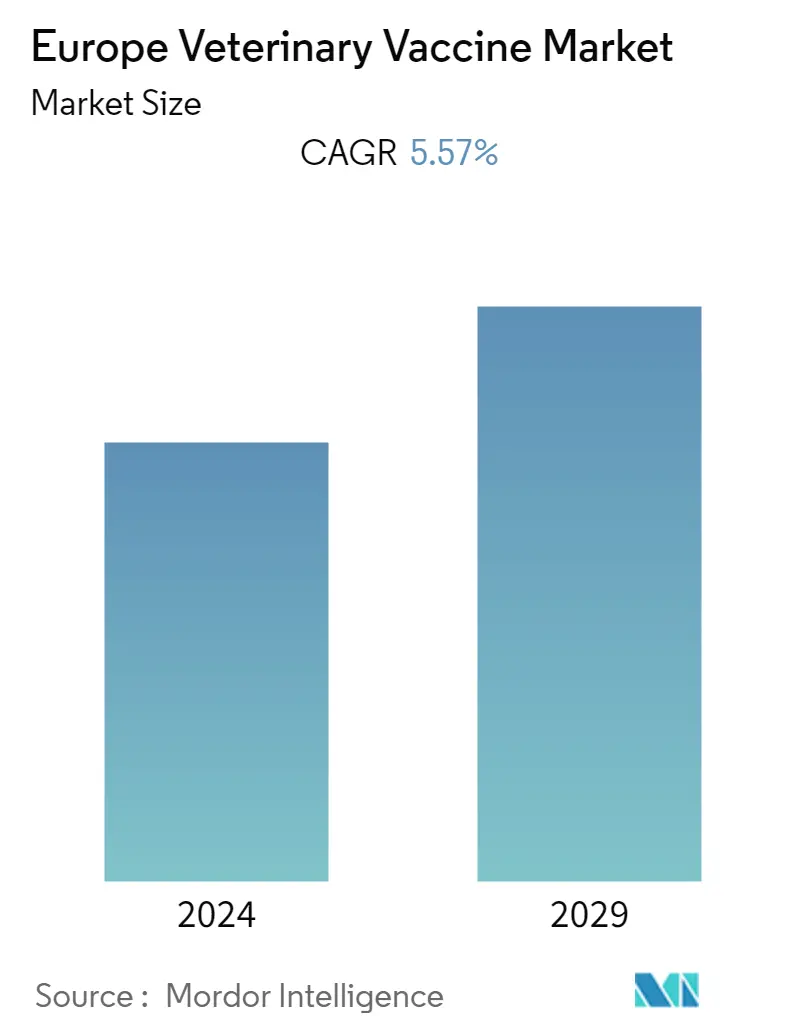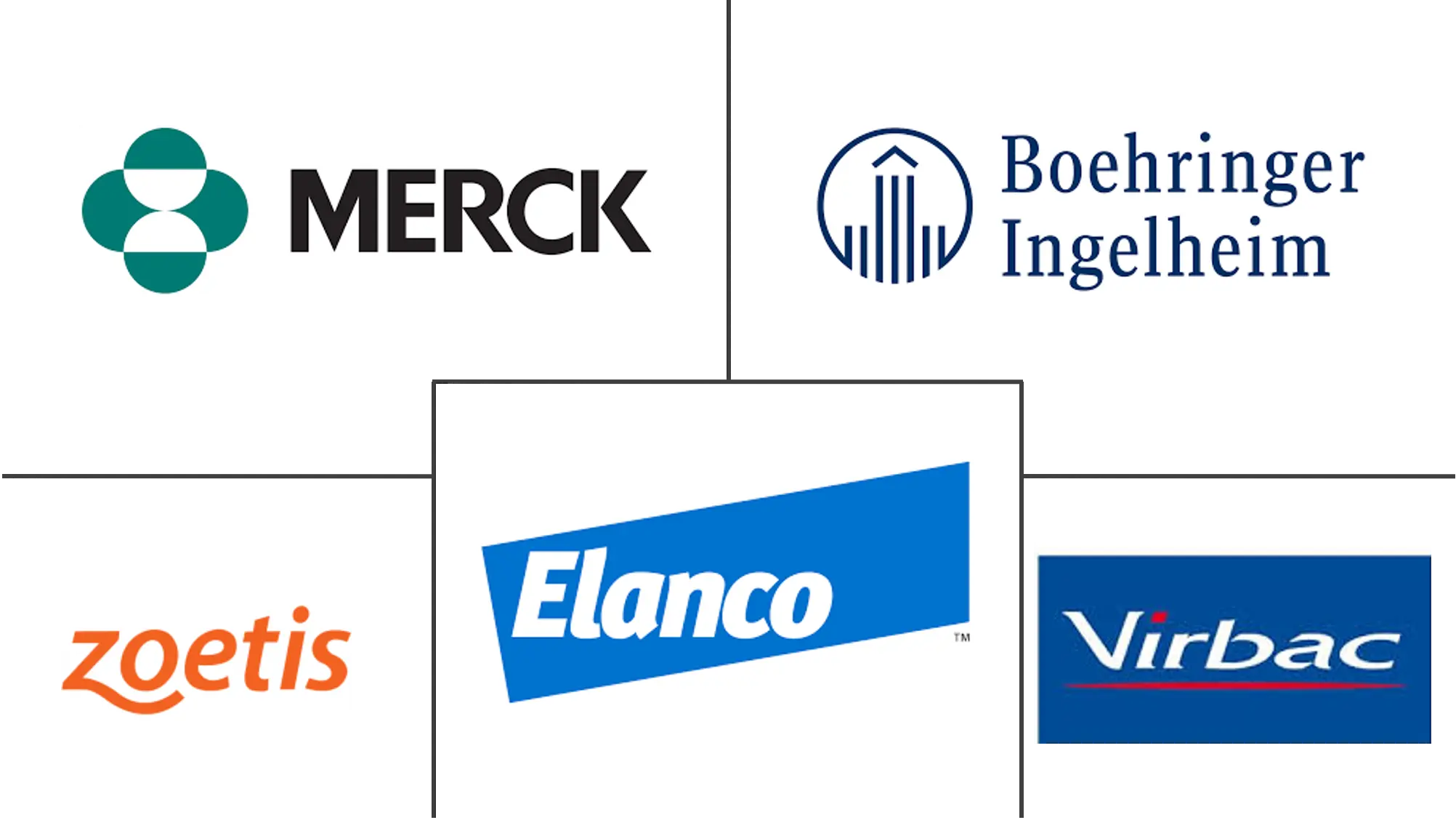Market Size of Europe Veterinary Vaccine Industry

| Study Period | 2021 - 2029 |
| Base Year For Estimation | 2023 |
| Forecast Data Period | 2024 - 2029 |
| Historical Data Period | 2021 - 2022 |
| CAGR | 5.57 % |
Major Players
*Disclaimer: Major Players sorted in no particular order |
Europe Veterinary Vaccine Market Analysis
The European veterinary vaccine market is expected to witness a CAGR of 5.57% over the forecast period.
The emergence of COVID-19 had an impact on the Europe veterinary vaccine market during the initial pandemic days due to the strict lockdown restrictions imposed by the government to curb the spread of COVID-19, which led to a decline in the demand for veterinary vaccines in Europe. However, the market is recovering since the lockdown restrictions were lifted in the European region, and as the cases of COVID-19 are on the decline and the demand for veterinary vaccines in Europe is increasing, thus fueling the growth of the market over the forecast period.
The key factors propelling the growth of this market are increasing incidences of livestock diseases, initiatives by various government agencies and animal associations, and key market players' strategies in the European region. For instance, according to an NCBI article published in November 2021, the incidence of Cryptosporidium, which affects cows, was 25.7% in Belgium, 24.9% in France, and 20.8% in the Netherlands. The report also mentioned that, overall, 93% of the farms in Western Europe were Cryptosporidium positive. Such a high incidence of livestock diseases is expected to be one of the crucial driving factors for the growth of the market over the forecast period.
In addition, per the Government of United Kingdom data in May 2022, nearly 1,832 African swine fever cases were recorded in Europe among domestic pigs. Such a burden of infectious diseases among animals across the European region is expected to increase the demand for veterinary vaccines, thereby contributing to the growth of the market during the forecast period. Also, the increasing product developments by the market players in Europe are expected to contribute to the market's growth during the forecast period. For instance, In September 2021, Boehringer Ingelheim received a positive opinion from the European Union for the combined use of Ingelvac CircoFLEX and Ingelvac PRRSFLEX EU for pig health management. The combined administration of both vaccines represents innovation in pig health management.
Likewise, the large size of the livestock and cattle population in the European region is also expected to contribute to the growing demand for veterinary vaccines, thereby fueling market growth. For instance, in the data published by Eurostat in May 2022, the European Union had approximately 289 million livestock animals in December 2021. Thus, the factors mentioned above, such as the growing prevalence of zoonotic diseases, the large size of the veterinary population, and increasing product launches, are expected to drive the growth of the studied segment during the forecast period. However, high storage costs for vaccines and lack of veterinarians, and a shortage of skilled farmers are expected to restrain the growth of the market over the forecast period.
Europe Veterinary Vaccine Industry Segmentation
As per the scope of the report, veterinary vaccines are used to immunize domestic, livestock, or companion animals to prevent the spread of infectious diseases caused by various pathogens and to provide protection to animals from various life-threatening diseases. The Europe Veterinary Vaccine Market is Segmented by Animal Vaccine Type (Livestock Vaccines and Companion Animal Vaccines), Technology (Live Attenuated Vaccines, Inactivated Vaccines, Toxoid Vaccines, Recombinant Vaccines, and Other Technologies), and Geography (Germany, United Kingdom, France, Italy, Spain and Rest of Europe). The report offers the value (in USD million) for the above segments.
| By Animal Vaccine Type | ||||||
| ||||||
|
| By Technology | |
| Live Attenuated Vaccines | |
| Inactivated Vaccines | |
| Toxoid Vaccines | |
| Recombinant Vaccines | |
| Other Technologies |
| Geography | |
| Germany | |
| United Kingdom | |
| France | |
| Spain | |
| Italy | |
| Rest of Europe |
Europe Veterinary Vaccine Market Size Summary
The European veterinary vaccine market is poised for significant growth, driven by an increasing incidence of livestock diseases and the large size of the veterinary population. The market is recovering from the initial impacts of COVID-19, with rising demand for veterinary vaccines as restrictions have eased. Key factors such as government initiatives, animal associations, and strategic actions by major market players are propelling this growth. The prevalence of diseases like Cryptosporidium and African swine fever has heightened the need for effective vaccination solutions, further boosting market expansion. Additionally, innovations in vaccine development, such as the combined use of Ingelvac CircoFLEX and Ingelvac PRRSFLEX EU, are contributing to the market's positive trajectory.
The live attenuated vaccines segment is expected to experience rapid growth due to their efficacy in managing veterinary diseases, offering strong cellular and antibody responses that often confer lifelong immunity. This segment's dominance is supported by the availability of authorized vaccines, such as Nobivac DP plus, which protects against multiple infections. Germany is anticipated to hold a significant market share, driven by the rising adoption of pets and a large livestock population, necessitating increased vaccination efforts. The market is moderately competitive, with major players like Zoetis Inc., Merck & Co. Inc., and Boehringer Ingelheim International GmbH holding substantial shares. Collaborative efforts, such as Boehringer Ingelheim's partnership with MabGenesis, highlight ongoing advancements in veterinary therapeutics, further supporting market growth.
Europe Veterinary Vaccine Market Size - Table of Contents
-
1. MARKET DYNAMICS
-
1.1 Market Overview
-
1.2 Market Drivers
-
1.2.1 High Burden of Livestock Diseases
-
1.2.2 Initiatives by Various Government Agencies, Animal Associations, and Leading Players
-
1.2.3 Increasing Incidences of Zoonotic Diseases
-
-
1.3 Market Restraints
-
1.3.1 High Storage Costs for Vaccines
-
1.3.2 Lack of Veterinarians and Shortage of Skilled Farmers
-
-
1.4 Porter Five Forces
-
1.4.1 Threat of New Entrants
-
1.4.2 Bargaining Power of Buyers/Consumers
-
1.4.3 Bargaining Power of Suppliers
-
1.4.4 Threat of Substitute Products
-
1.4.5 Intensity of Competitive Rivalry
-
-
-
2. MARKET SEGMENTATION (Market Size by Value - USD million)
-
2.1 By Animal Vaccine Type
-
2.1.1 Livestock Vaccines
-
2.1.1.1 Bovine Vaccines
-
2.1.1.2 Poultry Vaccines
-
2.1.1.3 Porcine Vaccines
-
2.1.1.4 Other Livestock Vaccines
-
-
2.1.2 Companion Animal Vaccines
-
2.1.2.1 Canine Vaccines
-
2.1.2.2 Feline Vaccines
-
2.1.2.3 Equine Vaccines
-
-
-
2.2 By Technology
-
2.2.1 Live Attenuated Vaccines
-
2.2.2 Inactivated Vaccines
-
2.2.3 Toxoid Vaccines
-
2.2.4 Recombinant Vaccines
-
2.2.5 Other Technologies
-
-
2.3 Geography
-
2.3.1 Germany
-
2.3.2 United Kingdom
-
2.3.3 France
-
2.3.4 Spain
-
2.3.5 Italy
-
2.3.6 Rest of Europe
-
-
Europe Veterinary Vaccine Market Size FAQs
What is the current Europe Veterinary Vaccine Market size?
The Europe Veterinary Vaccine Market is projected to register a CAGR of 5.57% during the forecast period (2024-2029)
Who are the key players in Europe Veterinary Vaccine Market?
Zoetis Inc., Merck & Co. Inc., Virbac SA, Boehringer Ingelheim International GmbH and Elanco are the major companies operating in the Europe Veterinary Vaccine Market.

